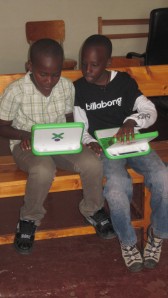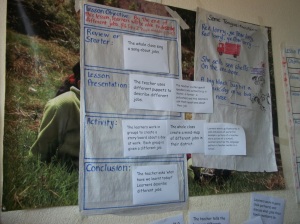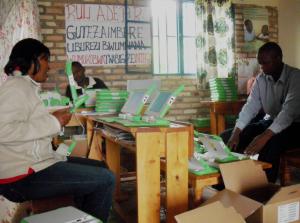Part I. Jean Piaget And Constructivism ” theory of knowing”
Who is Jean Piaget?Jean Piaget, (9 August 1896 – 16 September 1980) was a French-speaking Swiss developmental psychologist and philosopher known for his epistemological studies with children. His theory of cognitive development and epistemological view are together called “genetic epistemology”.
Piaget placed great importance on the education of children. As the Director of the International Bureau of Education, he declared in 1934 that “only education is capable of saving our societies from possible collapse, whether violent, or gradual.
Piaget created the International Center for Genetic Epistemology in Geneva in 1955 and directed it until 1980. According to Ernst Von Glasersfeld, Jean Piaget is “the great pioneer of the constructivism theory of knowing.
Piaget and Constructivism
Piaget’s theory provides a solid framework for understanding children’s ways of doing and thinking at different levels of their development. It gives us a precious window into what children are generally interested in and capable of at different ages.
To Piaget, what’s more, children not only have own views of the world (which differ from those of adults), but these views are extremely coherent and robust. They are stubborn, if you wish, not easy to shake. Children in this sense are not incomplete adults. Their ways of doing and thinking have an integrity, a “logic” of its own, that is mostly well suited to their current needs and possibilities. This is not to say that children’s views of the world, as well as of themselves, do not change through contact with others and with things.
The viewsare continually evolving. Yet, knowledge, Piaget tells us, expands and plateaus from within, and according to complex laws of self-organisation. To conclude, for a child—or an adult—to abandon a current working theory, or believe system, requires more than being exposed to a better theory. Conceptual changes in children, like theory changes in scientists, emerge as a result of people’s action- in-the-world, or experience, in conjunction with a host of ‘hidden’ processes at play to equilibrate, or viably compensate, for surface perturbations
The implications of such a view for education are trifold:
1. Teaching is always indirect. Kids don’t just take in what’s being said. Instead, they interpret what they hear in the light of their own knowledge and experience. They transform the input.
2 The transmission model, or conduit metaphor, of human communication won’t do. To Piaget, knowledge is not information to be delivered at one end, and encoded, memorized, retrieved, and applied at the other end. Instead, knowledge is experience that is acquired through interaction with the
world, people and things.
3. A theory of learning that ignores resistances to learning misses the point. Piaget shows that indeed kids have good reasons not to abandon their views in the light of external perturbations. Conceptual change has almost a life of its own.
While capturing what is common in children’s thinking at different developmental stages—and describing how this commonality evolves over time— Piaget’s theory tends to overlook the role of context, uses, and media, as well as the importance of individual preferences or styles, in human learning and development . That’s where Papert’s “constructionism” comes in handy… To be continued later.
Seymour Papert and Constuctionism learn by doing theory
Seymour Papert of Massachusetts Imnstitute of Technologies developed a heory of learning based upon Piaget’s constructivism. Note that Papert worked with Piaget in Geneva in the late 1950’ies and early 1960’ies. In his own words: “Constructionism—the N word as opposed to the V word— shares contructivism’s view of learning as “building knowledge structures”through progressive internalization of actions… It then adds the idea that this happens especially felicitously in a context where the learner is consciously engaged in constructing a public entity, whether it’s a sand castle on the beach or a theory of the universe ( Papert, 1991, p.1) Because of its greater focus on learning through making rather than overall cognitive potentials, Papert’s approach helps us understand how ideas get formed
and transformed when expressed through different media, when actualized in particular contexts, when worked out by individual minds. The emphasis shifts from universals to individual learners’ conversation with their own favorite representations, artifacts, or objects-to-think with.
To Papert, projecting out our inner feelings and ideas is a key to learning.
Expressing ideas makes them tangible and shareable which, in turn, informs, i.e., shapes and sharpens these ideas, and helps us communicate with others through our expressions. The cycle of self-directed learning is an iterative process by which learners invent for themselves the tools and mediations that best support the exploration of what they most care about. Learners, young and old, are “word-
makers,” in Nelson Goodman’s sense.
Stressing the importance of externalizations as a means to augment the unaided mind is not new. Vygotsky has spent his entire life studying the role of cultural artifacts—tools, language, people—as a resource for drawing the best out of every person’s cognitive potential. So have many other researchers in the socio- constructivist tradition. The difference, as I see it, lays in 3 things:
- In the role such external aids are meant to play at higher levels of a person’s development,
- In the types of external aids, or media, studied (Papert focuses on digital media and computer-based technologies) and more important, 3. In the type of initiative the learner takes in the design of her own “objects to think with”.
To Papert, knowledge, even in adult experts, remains essentially grounded in contexts, and shaped by uses, and the use of external supports and mediation remains, in his mind, essential to expand the potentials of the human mind—at any level of their development. Papert’s constructionism, in other words, is both more situated more pragmatic than Piaget’s constructivism.
What are then the differences between both theories ( Constructivism Vesus Constructionism)?
To conclusion: Piaget & Papert: Similar Goals, Different Means Piaget and Papert are both constructivists in that they view children as the builders of their own cognitive tools, as well as of their external realities. For
them, knowledge and the world are both constructed and constantly reconstructed through personal experience. Each gains existence and form through the construction of the other. Knowledge is not merely a commodity to be transmitted, encoded, retained, and re-applied, but a personal experience to beconstructed.
Similarily, the world is not just sitting out there waiting to be to be uncovered, but gets progressively shaped and transformed through the child’s, or the scientist’s, personal experience. Piaget and Papert are also both developmentalists in that they share an incremental view of knowledge construction. The common objective is to highlight the processes by which people outgrow their current views of the world, and construct deeper understandings about themselves and their environment. In their empirical investigations, Piaget and Papert both study the conditions under which learners are likely to maintain or change their theories of a given
phenomenon through interacting with it during a significant period of time. Despite these important convergences, the approaches of the two thinkers nonetheless differ. Understanding these differences requires a clarification of what each thinker means by intelligence, and of how he chooses to study it.
In appearance, both Piaget and Papert define intelligence as adaptation, or the ability to maintain a balance between stability and change, closure and 7 openess, continuity and diversity, or, in Piaget’s words, between assimilation and accommodation.
And both see psychological theories as attempts to model how people handle such difficult balances. At a deeper level, however, the difference is that Piaget’s interest was mainly in the construction of internal stability (la conservation et la reorganisation des acquis), whereas Papert is more interested in the dynamics of change (la decouverte de nouveaute). Allow me to elaborate: Piaget’s theory relates how children become progressively detached from the world of concrete objects and local contingencies, gradually becoming able to
mentally manipulate symbolic objects within a realm of hypothetical worlds. He studied children’s increasing ability to extract rules from empirical regularities and to build cognitive invariants. He emphasized the importance of such cognitive invariants as means of interpreting and organizing the world. One could say that
Piaget’s interest was in the assimilation pole. His theory emphasizes all those things needed to maintain the internal structure and organization of the cognitive system. And what Piaget describes particularly well is precisely this internal structure and organization of knowledge at different levels of development.
Papert’s emphasis lies almost at the opposite pole. His contribution is to remind us that intelligence should be defined and studied in-situ; alas, that being intelligent means being situated, connected, and sensitive to variations in the environment. In contrast to Piaget, Papert draws our attention to the fact that
“diving into” situations rather than looking at them from a distance, that connectedness rather than separation, are powerful means of gaining understanding. Becoming one with the phenomenon under study is, in his view, a key to learning. It’s main function is to put empathy at the service of intelligence.
To conclude, Papert’s research focuses on how knowledge is formed and transformed within specific contexts, shaped and expressed through different media, and processed in different people’s minds. While Piaget liked to describe the genesis of internal mental stability in terms of successive plateaus of equilibrium, Papert is interested in the dynamics of change. He stresses the fragility of thought during transitional periods. He is concerned with how different people think once their convictions break down, once alternative views
sink in, once adjusting, stretching, and expanding their current view of the world becomes necessary. Papert always points toward this fragility, contextuality, and flexibility of knowledge under construction.
Last but not least, the type of “children” that Piaget and Papert depict in their theories are different and much in tune with the researchers’ personal styles and scientific interests. Note that all researchers ‘construct” their own idealized child. Piaget’s “child,” often referred to as an epistemic subject, is a representative of
the most common way of thinking at a given level of development. And the “common way of thinking” that Piaget captures in his descriptions is that of a young scientist whose purpose is to impose stability and order over an ever changing physical world. I like to think of Piaget’s child as a young Robinson
Crusoe in the conquest of an unpopulated yet naturally rich island. Robinson’s conquest is solitary yet extremely exciting since the explorer himself is an inner-driven, very curious, and independent character. The ultimate goal of his adventure is not the exploration as such, but the joy of stepping back and being
able to build maps and other useful tools in order to better master and control the territory under exploration.
Papert’s “child,” on the other hand, is more relational and likes to get in tune with others and with situations. S/he resembles what Sherry Turkle describes as a “soft” master (Turkle, 1984). Like Piaget’s Robinson, s/he enjoys discovering novelties, yet unlike him, s/he likes to remain in touch with situations (people and
things) for the very sake of feeling at one with them.3 Like Robinson, s/he learns from personal experience rather than from being told. Unlike him, s/he enjoys gaining understanding from singular cases, rather than extracting and applying general rules. S/he likes to be engaged in situations and not step back from them.
S/he might be better at pointing at what s/he understands while still in context, than at telling what s/he experienced in retrospect.







